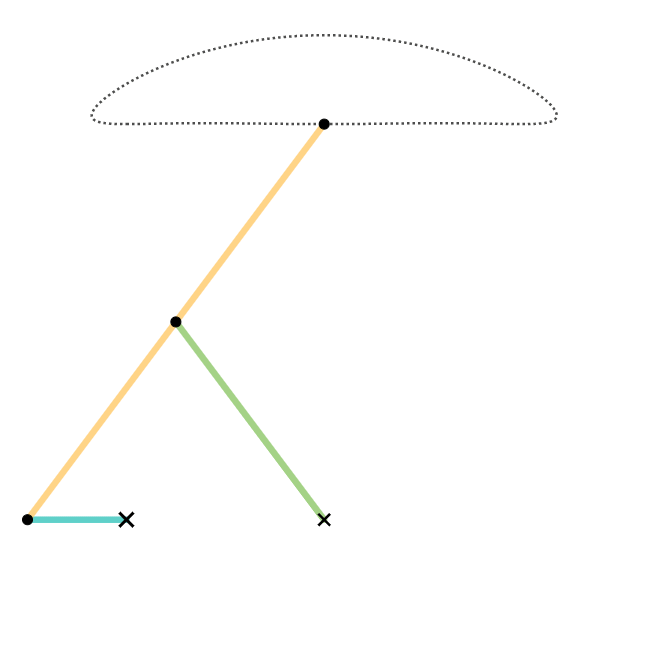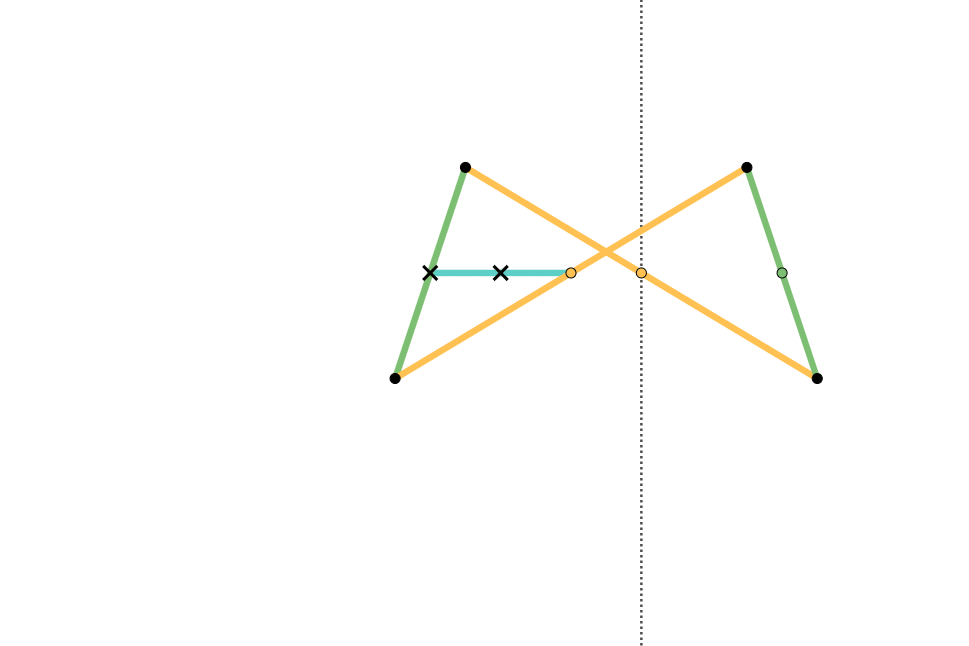|
Straight Line Mechanism
A straight-line mechanism is a Mechanism (engineering), mechanism that converts any type of rotary or angular motion to perfect or near-perfect straight-line motion, or ''vice-versa''. Straight-line motion is linear motion of definite length or "stroke", every forward stroke being followed by a return stroke, giving reciprocating motion. The first such mechanism, patented in 1784 by James Watt, produced approximate straight-line motion, referred to by Watt as Watt's linkage, parallel motion. Straight-line mechanisms are used in a variety of applications, such as engines, vehicle suspensions, walking robots, and rover wheels. History In the late eighteenth century, before the development of the Planer (metalworking), planer and the milling machine, it was extremely difficult to machine straight, flat surfaces. During that era, much thought was given to the problem of attaining a straight-line motion, as this would allow the flat surfaces to be machined. To find a solution ... [...More Info...] [...Related Items...] OR: [Wikipedia] [Google] [Baidu] |
Roberts Linkage
A Roberts linkage is a four-bar linkage which converts a rotational motion to approximate straight line mechanism, straight-line motion. The linkage was developed by Richard Roberts (engineer), Richard Roberts. The Roberts linkage can be classified as: * Watt's linkage, Watt-type linkage * Grashof condition, Grashof rocker-rocker * Symmetrical four-bar linkage References See also *Straight line mechanism *Four-bar linkage {{Mech-engineering-stub Linkages (mechanical) Straight line mechanisms ... [...More Info...] [...Related Items...] OR: [Wikipedia] [Google] [Baidu] |
Chebyshev Lambda Linkage
In kinematics, the Chebyshev Lambda Linkage is a four-bar linkage that converts rotational motion to approximate straight-line motion with approximate constant velocity. It is so-named because it looks like a lowercase Greek letter lambda (λ). The precise design trades off straightness, lack of acceleration, and the proportion of the driving rotation that is spent in the linear portion of the full curve. The example to the right spends over half of the cycle in the near straight portion. Coupler (link 3) point stays within 1% positional tolerance with intersecting the ideal straight line 6 times. The linkage was first shown in Paris on the Exposition Universelle (1878) as "The Plantigrade Machine". The Chebyshev Lambda Linkage is a cognate linkage of the Chebyshev linkage. The Chebyshev Lambda Linkage is used in vehicle suspension mechanisms, walking robots and rover wheel mechanisms. In 2004, a study completed as a Master of Science Thesis at Izmir Institute of Technology ... [...More Info...] [...Related Items...] OR: [Wikipedia] [Google] [Baidu] |
Scott Russell Linkage
A Scott Russell linkage is a linkage which translates linear motion through a right angle. The linkage is named after John Scott Russell (1808–1882), although watchmaker William Freemantle had already patented it in 1803. A different form of the linkage has been used in a front-wheel-drive vehicle with solid rear axle to control lateral movement, and with a flexing elastomeric connection instead of the rolling or sliding connection. The linkage does not share the disadvantages of the asymmetric Panhard rod, and although more compact than Watt's linkage, it has all the forces concentrated in one link. Construction and related linkages The linkage is composed of two links. One link is double the size of the other, and is connected to the smaller link by its midpoint. One of the ends is then connected to something that can generate linear motion, such as a rolling or sliding connection, or another straight line mechanism. The Evans 'grasshopper' linkage is a variant of a ... [...More Info...] [...Related Items...] OR: [Wikipedia] [Google] [Baidu] |
Quadruplanar Inversor
The Quadruplanar inversor of Sylvester and Kempe is a generalization of Hart's inversor. Like Hart's inversor, is a mechanism that provides a perfect straight line motion without sliding guides. The mechanism was described in 1875 by James Joseph Sylvester in the journal Nature (journal), Nature. Like Hart's inversor, it is based on an antiparallelogram but the rather than placing the fixed, input and output points on the sides (dividing them in fixed proportion so they are all similar), Sylvester recognized that the additional points could be displaced sideways off the sides, as long as they formed similar triangles. Hart's original form is simply the degenerate case of triangles with altitude zero. Gallery In these diagrams: * The antiparallelogram is highlighted in full opacity links. * Yellow Triangles and Green Triangles are similar. ** Green Triangles are congruent with each other. ** Yellow Triangles are congruent with each other. * Cyan links and Pink links are congru ... [...More Info...] [...Related Items...] OR: [Wikipedia] [Google] [Baidu] |
Hart's Inversor
Hart's inversors are two planar mechanisms that provide a perfect straight line motion using only rotary joints. They were invented and published by Harry Hart in 1874–5. Hart's first inversor, also known as ''Hart's W-frame'', is based on an antiparallelogram. The addition of fixed points and a driving arm make it a 6-bar linkage. It can be used to convert rotary motion to a perfect straight line by fixing a point on one short link and driving a point on another link in a circular arc. Hart's second inversor, also known as ''Hart's A-frame'', is less flexible in its dimensions, but has the useful property that the motion perpendicularly bisects the fixed base points. It is shaped like a capital A – a stacked trapezium and triangle. It is also a 6-bar linkage. Example dimensions These are the example dimensions that you see in the animations on the right. Mecanismo de Hart (2).png, Mecanismo de Hart.png, See also ... [...More Info...] [...Related Items...] OR: [Wikipedia] [Google] [Baidu] |
Peaucellier–Lipkin Linkage
The Peaucellier–Lipkin linkage (or Peaucellier–Lipkin cell, or Peaucellier–Lipkin inversor), invented in 1864, was the first true planar straight line mechanism – the first planar linkage capable of transforming rotary motion into perfect straight-line motion, and vice versa. It is named after Charles-Nicolas Peaucellier (1832–1913), a French army officer, and Yom Tov Lipman Lipkin (1846–1876), a Lithuanian Jew and son of the famed Rabbi Israel Salanter. Until this invention, no planar method existed of converting exact straight-line motion to circular motion, without reference guideways. In 1864, all power came from steam engines, which had a piston moving in a straight-line up and down a cylinder. This piston needed to keep a good seal with the cylinder in order to retain the driving medium, and not lose energy efficiency due to leaks. The piston does this by remaining perpendicular to the axis of the cylinder, retaining its straight-line motion. ... [...More Info...] [...Related Items...] OR: [Wikipedia] [Google] [Baidu] |
Sarrus Linkage
The Sarrus linkage, invented in 1853 by Pierre Frédéric Sarrus, is a mechanical linkage to convert a limited circular motion to a linear motion or vice versa without reference guideways. It is a spatial six-bar linkage (6R) with two groups of three parallel adjacent joint-axes. Although Charles-Nicolas Peaucellier was widely recognized for being the first to invent such a straight-line mechanism, the Sarrus linkage had been invented earlier; however, it was largely unnoticed for a time. – Sarrus' mechanism Description The Sarrus linkage consists of four links in two identical groups that are perpendicular to each other, with all links having equal lengths. In the examples shown, the linkage uses two horizontal plates (cyan) ...[...More Info...] [...Related Items...] OR: [Wikipedia] [Google] [Baidu] |
Inversive Geometry
Inversive activities are processes which self internalise the action concerned. For example, a person who has an Inversive personality internalises his emotions from any exterior source. An inversive heat source would be a heat source where all the heat remains within the object and is not subject to any format of transference Transference (german: Übertragung) is a phenomenon within psychotherapy in which the "feelings, attitudes, or desires" a person had about one thing are subconsciously projected onto the here-and-now Other. It usually concerns feelings from a ... or externalisation. Is the opposite of Transversive activities and objects which suggest by their very nature that the outcome is transferred to the secondary source. Psychoanalytic terminology Emotion ... [...More Info...] [...Related Items...] OR: [Wikipedia] [Google] [Baidu] |
Hoecken Linkage
In kinematics, the Hoecken linkage (named for Karl Hoecken) is a four-bar linkage that converts rotational motion to approximate straight-line motion. The Hoecken linkage is a cognate linkage of the Chebyshev linkage and Chebyshev's Lambda Mechanism. The linkage was first published in 1926. A generalization of the Hoecken linkage is Wittgenstein's rod. See also *Chebyshev linkage and Chebyshev lambda linkage, linkages that produce a very similar locus without the need of a sliding joint. *Straight line mechanism *Four-bar linkage In the study of mechanisms, a four-bar linkage, also called a four-bar, is the simplest closed- chain movable linkage. It consists of four bodies, called ''bars'' or ''links'', connected in a loop by four joints. Generally, the joints are configu ... References External links Straight line mechanisms Linkages (mechanical) {{technology-stub ... [...More Info...] [...Related Items...] OR: [Wikipedia] [Google] [Baidu] |






